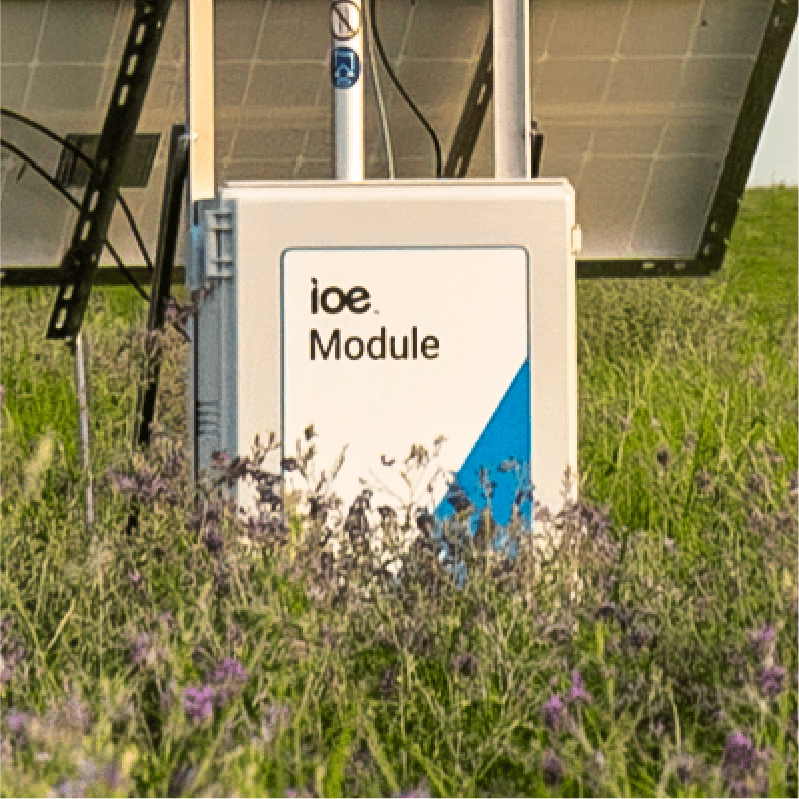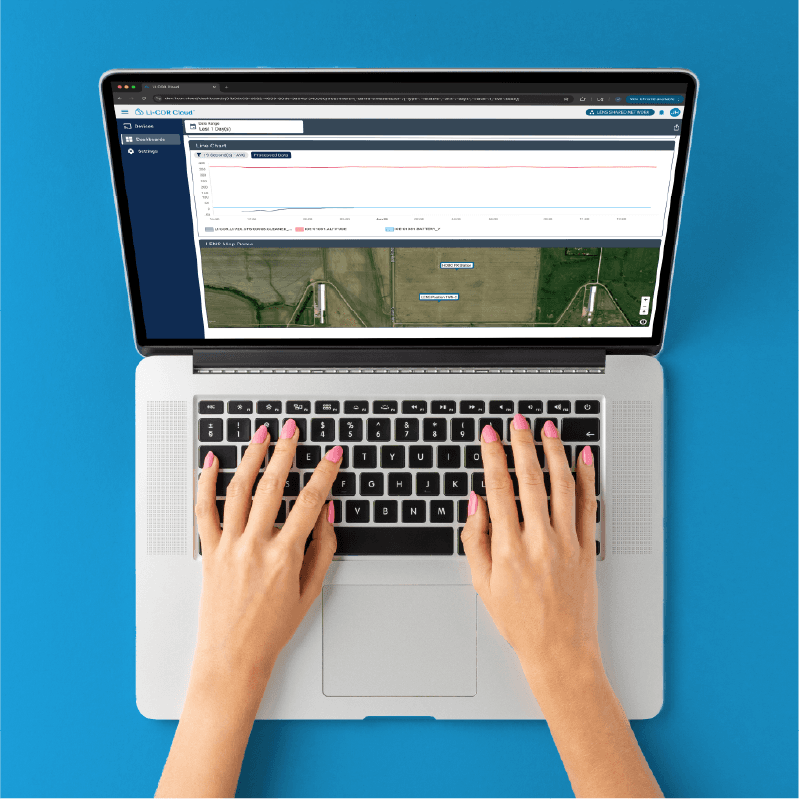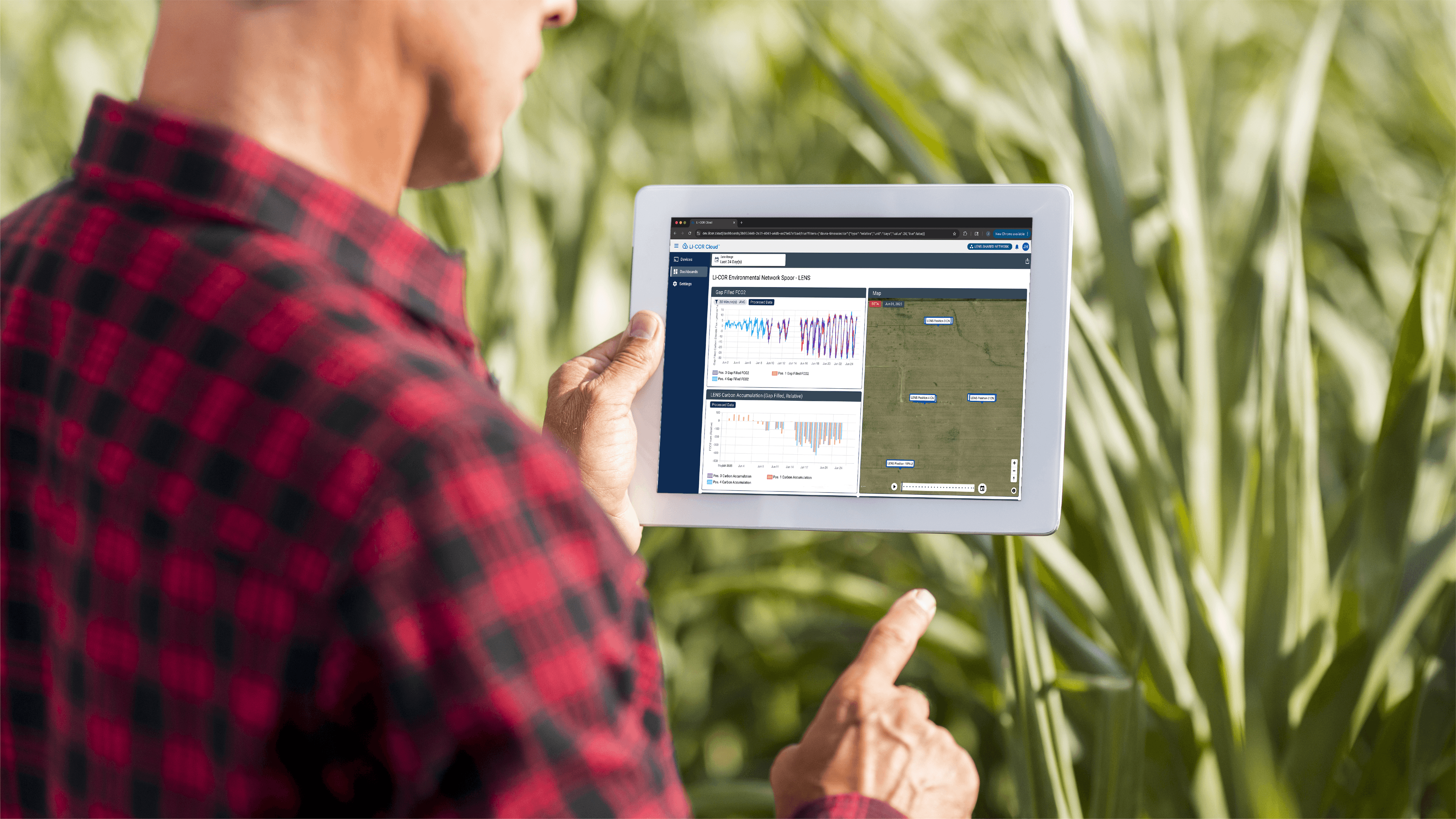What could
0% water savings
do for you?
Upcoming Webinar
LI-COR Cloud® × FluxMapper™:
Turning Flux Towers into Spatially Aware Observatories
THURSDAY, JANUARY 22, 2026
Register NowKNOW YOUR ACTUAL WATER USE
When water is precious, managing it requires increased precision. Traditional methods provide estimations of evapotranspiration (ET). Instead of estimating, modernize your ET measurements with the Water Node from LI-COR. Our streamlined, all-in-one solution quickly gives you directly measured, actual evapotranspiration data.
The Water Node uses a single sensor–the LI-710 Evapotranspiration Sensor–to deliver accurate, actual ET measurements. Easy to install or move, the sensor connects automatically to cloud-based software where you can get trustworthy data to make confident decisions about your water use.
Accurate, Actual ET
All-in-One Solution
Automated Results
GET ACTUAL ET DATA,
NOT ESTIMATES
The eddy covariance method is the scientifically validated standard for measuring actual evapotranspiration. However, the method has traditionally been a high-cost and complex undertaking for the research community. For practical applications, a formula is used for calculating estimated evapotranspiration instead of directly measuring ET. This calculation requires a cluster of basic sensors that measure temperature, relative humidity, wind speed, and solar radiation. The problem with estimated ET measurements is that they lack precision and accuracy and leave you with high risk in your water management plan. Ultimately, estimates lead to overwatering.
Using the only sensor that measures actual evapotranspiration, the Water Node provides real-time, validated data you can trust to make informed decisions about:
- • Irrigation management
- • Water budgeting
- • Drought monitoring
- • Verification of remote sensing
- • Regulatory oversight
- • Watershed management
AN OUT-OF-THE-BOX
TURNKEY SOLUTION
The Water Node includes all the hardware and software you need to take actual evapotranspiration measurements: the LI-710 Evapotranspiration Sensor, an Internet of the Environment (IoE) module, and software in LI-COR Cloud. The all-in-one solution is easy to set up, self-powered, and low maintenance, so you can scale your ET measurements across a large site or to multiple locations. When you move the Water Node, GPS automatically recognizes the new location and displays it in the Cloud. Within minutes of setup, all your ET data is automatically available in our cloud-based software.

LI-710 Evapotranspiration Sensor
Hardware
A single sensor that measures actual ET from your site in real time

IoE Module
Hardware
On-site device that transfers the sensor’s data to LI-COR Cloud, where it can be accessed anytime, anywhere

LI-COR Cloud
Software
Cloud-based software that allows you and your team to remotely view, share, and download data
AUTOMATED ON-DEMAND DATA, ACCESSIBLE ANYWHERE
With software in LI-COR Cloud, you can concentrate on water management rather than data management. The platform empowers you to manage your entire evapotranspiration measurement system from a single centralized source.
- View all the variables for your project:
- Easily adjust your variables for the ET sensor or the IoE Module.
- Add additional Water Nodes to scale up, then move them anywhere:
- GPS will automatically map all locations and update any changes.
- Invite additional users and share your data:
- Every team member can remotely access your ET data anywhere, anytime.
- Visualize the data your way:
- Change graph views with pre-defined or custom time windows.
- Supports automatic generation of the following data outputs:
- QAQC'ed Flux Data
- Gap-Filled Flux Data
- Daily accumulations of ET or FCO2
- Daily Flux Footprint Climatologies for each Node in your organization

Award-Winning Innovation in Environmental Monitoring
LI-COR has been honored with the prestigious "Internet of Environment Solution of the Year" award at the 2025 IoT Breakthrough Awards. This recognition highlights the innovation of the Internet of the Environment (IoE) Module, which simplifies real-time data collection and analytics for ecosystem processes like evapotranspiration. The IoT Breakthrough Awards program is dedicated to recognizing outstanding achievements in Internet-of-Things innovations, including technologies, services, companies, and products.
READ MOREBUILT ON THE SCIENTIFIC STANDARD BY THE INDUSTRY LEADERS

For more than 50 years, we have been building trusted tools for environmental monitoring. The leading global research networks use our solutions, and researchers worldwide trust our eddy covariance systems to take precise, accurate measurements for publication in high-impact, peer-reviewed journals.
We wrote the book on the eddy covariance method–and the Water Node is designed, engineered, and built on that foundation.
HOW DOES THE WATER NODE MEASURE ACTUAL EVAPOTRANSPIRATION?
The LI-710 Evapotranspiration Sensor applies the eddy covariance method to measurements of vertical wind and water vapor concentration at 10 Hz, providing fully processed results every 30 minutes.
See real-time data from a network of Water Nodes in our recent webinar.
Webinar
Real-Time Evapotranspiration Data: Advanced Solutions for Natural and Agricultural Environments
with Taylor Thomas
Watch RecordingWe compared measurements from the LI-710 Evapotranspiration Sensor to ET data calculated with the Penman-Monteith equation - the standard for estimating evapotranspiration. The Water Node reports lower cumulative daily evapotranspiration, so the equation results in overestimation. When compared with the eddy covariance method, the Water Node reports evapotranspiration with similar accuracy to traditional eddy covariance, but with a more streamlined solution.


The difference between the Water Node’s direct measurement and the estimate seems small–only 25-45 mm in the example above. However, when added up across an entire field for the complete growing season, the water savings comes to 3 million gallons of water.
Water Node Network: Enrich Your Evapotranspiration Monitoring with a Comprehensive Solution
Using a HOBOnet Node Link, you can directly link your Water Node to a scalable network of HOBOnet environmental sensors, which enables the integration of atmospheric flux, evapotranspiration, and high-resolution soil moisture data —giving you a comprehensive, precise ET monitoring solution and actionable insights that enhance your water resource management decisions and ecosystem monitoring.
See Water Node Network Solution